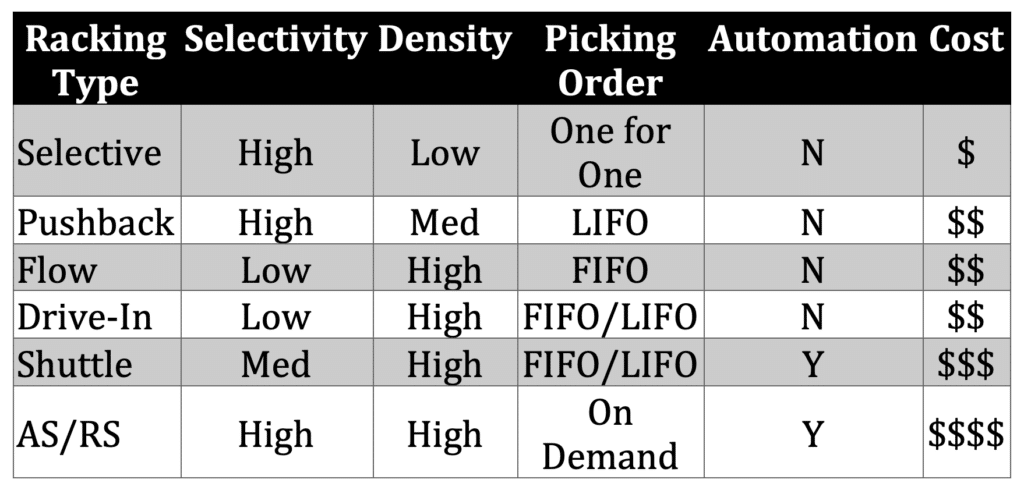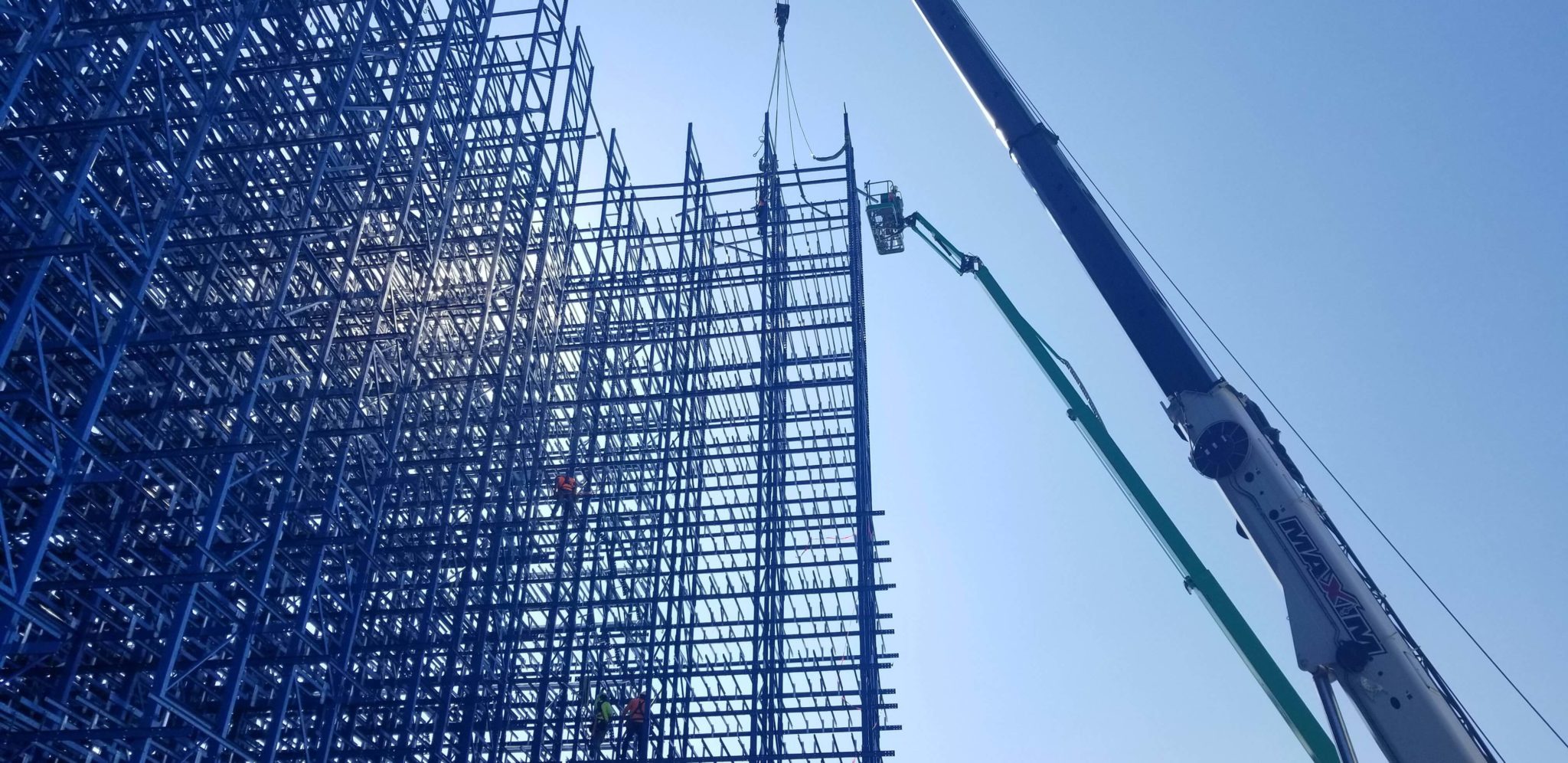Most people would say a warehouse is a warehouse – a place to store material and goods while they await usage or shipment. In general, this is true; however, each warehouse is more complicated than meets the eye and requires careful evaluation throughout the design process. Depending on the industry, type of facility, products, and limiting constraints such as available space and budget, each warehouse has unique opportunities in optimizing its role within its supply chain.
Understanding your Warehouse
Operation Type can drastically alter the way you think about its space and utilization. Distribution Centers (DC) need accommodate a high number of Stock Keeping Units (SKUs), which may need to be accessed at a moment’s notice. These SKUs can typically change often and the volume of pallets per SKU is driven by its demand. This fact lends itself to each SKU needing a different storage method to optimize the footprint of that SKU in the warehouse. While each DC has nuances in its function, most DCs can follow a similar methodology in contrast to production center warehouses (PC). PC Warehouses can also support production activities by storing raw materials, ingredients for batch production, or finished goods coming out of a production process waiting shipment. Production facilities tend to have a lower number of SKUs but with larger numbers of pallets/SKU. These warehouses must be designed with different considerations in mind which are discussed throughout the remainder of this article.
Product Throughput and On-Hand Inventories
Product throughput and on-hand inventories can provide deeper insight to the types of storage which would best support the role of your warehouse. Factors such as the number of Stock Keeping Units (SKU), product quantities, customer shipping requirements, and package types can all play a role in choosing the most effective racking solutions. Warehouses that deal
with many unique SKUs with low unit volumes can take advantage of rack types with high selectivity such as floor storage, selective or pushback racking. Operations that have more complicated product parsing will require closer attention to maintain efficient product delivery.
Certain rack types such as Drive-In/Drive-thru racking, Pallet Flow, Shuttle Racking are most effective at storing high quantities of a SKU in order to optimize a warehouse footprint.
However, these deeper lane solutions can have a lower ratio of pallets to locations. A few of the deeper lane solutions can be configured in LIFO or FIFO configuration that can help streamline operation flows and ensure all material batches are utilized effectively; the combination of which greatly decreases the operational cost of your facility. Automated Storage and Retrieval Systems (AS/RS) can be designed to handle all types of SKUs in the warehouse but might not always be the best option. The goal of any storage configuration is to maximize the space cube (LxWxH) of a warehouse while maintaining efficient put away and picking.
The table below outlines the differences between common rack types:

Equipment Capabilities and Requirements sheds light on additional constraints and opportunities of your warehousing operations. Some of the rack types discussed thus far have additional modifications that can be made to further improve their performance within your warehouse.
For example, selective racking can be modified to a Very Narrow Aisle (VNA) configuration which helps compensate for one of selective racking’s downsides – lack of storage density. Similarly, drive-in and other rack types can be configured to allow for handling two pallets at a time which aid in increasing throughput of a system thus alleviating any potential bottlenecks for processes upstream. While both are substantial improvements on their base configurations, both require specialized equipment. Additionally, using the full vertical height of your warehouse is critical to optimize your pallet count. However, you will need to ensure the lift and weight capabilities of your equipment can work with the racking-
Operational Flow should also be considered in order to maximize productivity while minimizing warehouse traffic. Making such optimizations can greatly improve the performance of your warehouse and ensure the operation teams will be able to handle all demands. Racks such as Flow-thru, Drive-thru, and Shuttle systems allow product and material to be put away on one end and picked from the opposite end, allowing segregation of warehouse operations while maintaining FIFO material flow. Utilizing these types of racks properly can transform the daily operations of a warehouse and elevate its capability.
Should you consider Automation?
Automation in a warehouse can offer a lot of advantages and cost savings opportunities. Technology, like pallet AS/RS, can often be justified in situations where the absolute highest pallet density is needed.
Situations where companies consider automation are the following:
- Warehouse consolidation
- Pallets or SKUs are exceeding the warehouse footprint
- Labor market is small or unreliable in the area
- Additional functions like e-commerce picking or local delivery are being added to a warehouse
There are several types and configurations of these systems and the right system is determined by the factors listed earlier such as operation type, SKUs, etc. It takes a detailed analysis of your data and processes to de-sign a system that works for your current and future needs. This analysis should be done by professionals to help concept and justify the right automation for your business.
No One Storage Type is Perfect
When evaluating a warehouse, considering different racking types can unlock unrealized potential of your warehousing space and help mitigate logistical and operational bottlenecks. The key to designing a warehouse is not to choose one right rack type, but to design the warehouse in a way that leverages the strengths of multiple storage types, which, when working together take full advantage of available space and budget of your warehouse.
Realizing the optimal balance is an intensive and iterative process; one which requires careful investigation and in-depth data analysis to understand the true capabilities of your warehouse. Falsely interpreting this information can leave you with a fragmented, inefficient warehouse with unrealized opportunity. The design process is the most important part of unlocking your warehousing potential and is one which the Advanced Facilities Group at Carroll Daniel Engineering has done for many clients. Carroll Daniel Engineering offers a non-biased approach to sizing both manual and automated solutions with the advantage of understanding the facility needs to make the solution work.


